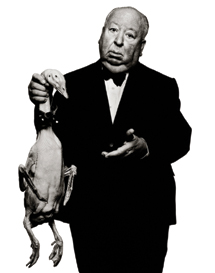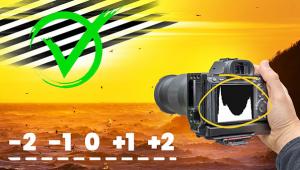Master Interview: Albert Watson; The Discerning Eye Page 2
AW: In the past 15 years, I've settled into the 4x5 as my weapon of choice. For every 100 shots I take on 4x5, I may do one frame on the Hasselblad. I've shot on Kodak film from the beginning. I've done fashion and movement in the studio with 4x5. There's a way you can work out the mechanics of it to make it work very, very well, to make sure that it's sharp and crisp and within frame, and the composition is good. Because, when you shoot 4x5, you shoot blind of course. Since you're shooting in the dark, as it were, you have to be very careful how you set that up. Sometimes, though, if there's a lot of high-energy stuff, like people on a trampoline, it's better to shoot in medium format.
 |
SB: You use a lot of different lighting techniques.
AW: I've always been comfortable with strobe or I can
use a light bulb. I'm using many things--natural light, fluorescent,
kinoflows, HMIs, tungsten, and strobe. I did get quite good with strobe.
SB: One of your photos of Kate Moss sold last year for more
than $100,000. What is the backstory of that picture?
AW: It was shot for German Vogue on a roof in Morocco, with
Tri-X on a Hasselblad. She was just 17 then and getting started. It is just
natural light, golden hour. I didn't view it at the time as being particular,
it was one of many shots. Nothing was more astounding than to have it sell last
summer for that amount of money. I would pay $5000 for it, but not over $100,000.
So it became a more important iconic shot as time went on.
 |
SB: What did you use for the picture of the flower seller's
hands holding flower petals in Marrakesh; how did you illuminate it and modulate
the light?
AW: It's daylight. I looked around for the best light
and found the spot I wanted, then I took a box over and had her sit there. This
is from natural light, not darkroom work. The Polaroid looked pretty much like
the print.
SB: What lighting did you use for the portrait of Gabrielle
Reece and Michaela, taken in L.A.?
AW: It's also natural light. But I have to be honest
with you. I'm very, very careful and I cheat sometimes. I always travel
with four to six "books" of folding foamcore, each opening to 8x8
feet, black on one side, white on the other. I don't just accept the natural
light--I'm working with it. A lot of photographers just use white
reflectors and they bring them in close. For this double portrait I manipulated
the light with four boards, but they were positioned about 15 feet from the
faces. You're swinging the light into the shot, you're bending it
in. You may not even be able to see the difference the reflectors make in a
contact sheet. But once you make a print, you can tell.
One of my sons is a photographer. The first big job he did was a fashion catalog
in Scotland. I had him take up eight double boards. What he did was, he might
have a girl leaning against a tree in a landscape, but the entire ground, out
of frame, was the white reflector boards. What you then saw was a wonderful
balance of light, because he was getting cloudy weather all the time.
SB: Your shot of Mick Jagger merged with the face of a leopard--was
that blended in the darkroom?
AW: No, it was a double exposure in camera. I shot the cat
first and drew its position on the Hasselblad's viewfinder. Then I rewound
the film and aligned Mick's eyes with the viewfinder drawing. Then I photographed
his face over the entire roll. Only one roll of film and I almost threw it out
before developing it, because I thought that it would never work, they'd
never match. When I got the film back, though, four of the frames were perfect.
 |
SB: Tell me about your photo of Alfred Hitchcock.
AW: This is one of my very first portrait assignments. It was
a fabulous experience. He was a wonderful person to photograph because he knew
I was nervous and shaky and about to pass out. He saw that and told me to relax.
After the shoot, he said, "You did very well. Would you like some tea?"
I then sat in the office and had tea and scones with him, chatting about film,
it was a very surreal moment.
The reason he's holding the bird is that he was gourmet chef, and the
photo was for an article with his recipe, called "Hitchcock Cooks His
Own Goose." I spent a lot of time trying to think what I could bring to
it. They wanted the goose cooked on a plate, but I thought it would be much
funnier to do it with him holding the uncooked fowl. And I put Christmas decorations
around the goose's neck.
SB: Throughout your career you've balanced personal fine
art projects with heavy-duty commercial work. What advice do you have for a
photographer on a commercial assignment?
AW: Remain true to yourself, and you will also be true to the
client, even if the art director on site disagrees. If there is a shot that
you feel strongly about, hold your ground and shoot at least a few frames of
it. You're trying to give them something special, something beautiful,
something magical. And you will never get that day back. I'm always looking
for some kind of strength and mystery mixed together.
SB: You've been called both a master printer and a perfectionist.
How does technique fit into your workflow?
AW: While technology is important, it's all part of a
marriage--technique and the idea. You just want to get all that stuff off
your back so you don't have to think about it, so the idea can come through.
Early on, I worked to learn as much about light as possible so that I can go
into a portrait session with someone and not spend my time fussing over it.
It's really about establishing a connection between me and my subject.
A portrait is very emotional in this way.
SB: At this point are you slowing down a bit?
AW: I'm very, very busy. The gallery and museum things
are doing very well. I have a very good team behind me that help me tremendously.
Phaidon just published a book last fall, Albert Watson, and a new one on Las
Vegas, all color, is scheduled for this year. I'm shooting all the time;
I did a Rolling Stone cover two weeks ago, I'm still doing some fashion,
and I direct a lot of TV commercials for companies like Chevrolet and NASDAQ.
My first love, though, will always be photography. When I get behind the camera,
time disappears, I enter a state of euphoria.
SB: You have a reputation for being a workaholic. What do you
like to do for fun and to relax?
AW: I like to go to museums, where I continue to work. And
I'm involved in a fierce, very nasty battle with my wife of 46 years in
Scrabble. We play a lot, especially on airplanes.
To see more of Albert Watson's work, visit www.albertwatson.com.
Howard Millard will be leading workshops this year in the U.S.A. and Italy. In Maryland, Digital Photo Art: April 11th-13th; Photoshop Tools and Techniques: July 11th-13th. In New York City, Gardens of New York: May 31st-June 1st; Travel--Capturing the Spirit of Manhattan: June 7th-8th; through Horizon Workshops (www.horizonworkshops.com, (410) 885-2433). For a week-long photo and culinary adventure in Tuscany, Travel Photography in the Digital Age: May 10th-17th; through Il Chiostro (www.ilchiostro.com, (800) 990-3506).
- Log in or register to post comments

















































